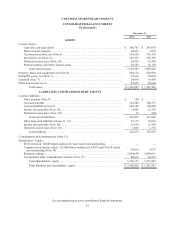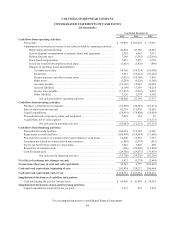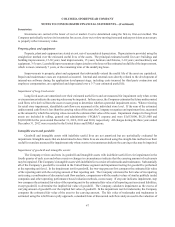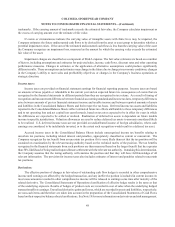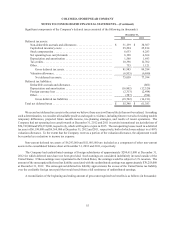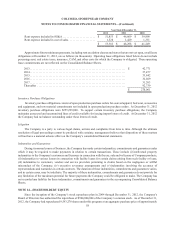Columbia Sportswear 2012 Annual Report Download - page 52
Download and view the complete annual report
Please find page 52 of the 2012 Columbia Sportswear annual report below. You can navigate through the pages in the report by either clicking on the pages listed below, or by using the keyword search tool below to find specific information within the annual report.COLUMBIA SPORTSWEAR COMPANY
NOTES TO CONSOLIDATED FINANCIAL STATEMENTS—(Continued)
48
trademarks. If the carrying amount of trademarks exceeds the estimated fair value, the Company calculates impairment as
the excess of carrying amount over the estimate of fair value.
If events or circumstances indicate the carrying value of intangible assets with finite lives may be impaired, the
Company estimates the future undiscounted cash flows to be derived from the asset or asset group to determine whether a
potential impairment exists. If the sum of the estimated undiscounted cash flows is less than the carrying value of the asset
the Company recognizes an impairment loss, measured as the amount by which the carrying value exceeds the estimated
fair value of the asset.
Impairment charges are classified as a component of SG&A expense. The fair value estimates are based on a number
of factors, including assumptions and estimates for projected sales, income, cash flows, discount rates and other operating
performance measures. Changes in estimates or the application of alternative assumptions could produce significantly
different results. These assumptions and estimates may change in the future due to changes in economic conditions, changes
in the Company’s ability to meet sales and profitability objectives or changes in the Company’s business operations or
strategic direction.
Income taxes:
Income taxes are provided on financial statement earnings for financial reporting purposes. Income taxes are based
on amounts of taxes payable or refundable in the current year and on expected future tax consequences of events that are
recognized in the financial statements in different periods than they are recognized in tax returns. As a result of timing of
recognition and measurement differences between financial accounting standards and income tax laws, temporary differences
arise between amounts of pre-tax financial statement income and taxable income and between reported amounts of assets
and liabilities in the Consolidated Balance Sheets and their respective tax bases. Deferred income tax assets and liabilities
reported in the Consolidated Balance Sheets reflect estimated future tax effects attributable to these temporary differences
and to net operating loss and net capital loss carryforwards, based on tax rates expected to be in effect for years in which
the differences are expected to be settled or realized. Realization of deferred tax assets is dependent on future taxable
income in specific jurisdictions. Valuation allowances are used to reduce deferred tax assets to amounts considered likely
to be realized. U.S. deferred income taxes are not provided on undistributed income of foreign subsidiaries, where such
earnings are considered to be indefinitely invested, or to the extent such recognition would result in a deferred tax asset.
Accrued income taxes in the Consolidated Balance Sheets include unrecognized income tax benefits relating to
uncertain tax positions, including related interest and penalties, appropriately classified as current or noncurrent. The
Company recognizes the tax benefit from an uncertain tax position if it is more likely than not that the tax position will be
sustained on examination by the relevant taxing authority based on the technical merits of the position. The tax benefits
recognized in the financial statements from such positions are then measured based on the largest benefit that has a greater
than 50% likelihood of being realized upon ultimate settlement with the relevant tax authority. In making this determination,
the Company assumes that the taxing authority will examine the position and that they will have full knowledge of all
relevant information. The provision for income taxes also includes estimates of interest and penalties related to uncertain
tax positions.
Derivatives:
The effective portion of changes in fair values of outstanding cash flow hedges is recorded in other comprehensive
income until earnings are affected by the hedged transaction, and any ineffective portion is included in current income. In
most cases amounts recorded in other comprehensive income will be released to earnings some time after maturity of the
related derivative. The Consolidated Statements of Operations classification of effective hedge results is the same as that
of the underlying exposure. Results of hedges of product costs are recorded in cost of sales when the underlying hedged
transaction affects earnings. Unrealized derivative gains and losses, which are recorded in assets and liabilities, respectively,
are non-cash items and therefore are taken into account in the preparation of the Consolidated Statements of Cash Flows
based on their respective balance sheet classifications. See Note 19 for more information on derivatives and risk management.





